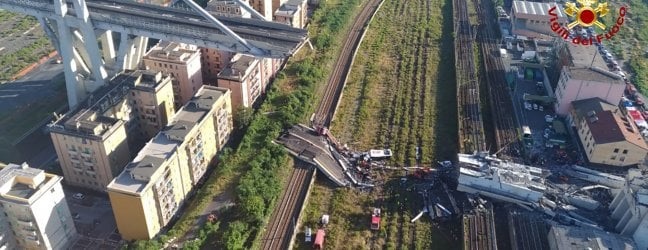The collapse of the Morandi highway bridge caused the death of at least 39 people on Tuesday, August 14th. A heated debate is taking place in Italy regarding the causes of this disaster and accountability.
Built in 1967, the bridge was criticized by several engineers for its construction flaws.
Constructed in 1967, it was slightly over 50 years old. Built by the Italian company Società Italiana per Condotte d’Acqua, the Morandi bridge was inaugurated in 1967 and allowed passage over the Polcevera River in Genoa, Italy.
Supported by three reinforced concrete pylons, this 1,182-meter-long viaduct, over which the A10 highway passed, was considered by its builders to be one of the most complex engineering works of its kind.
While awaiting the technical commission’s report to establish their analysis of probable causes, questions arise.
Who was responsible for the bridge’s maintenance?
The Italian Minister of Infrastructure and Transportation, Danilo Toninelli, declared on the day of the tragedy that this responsibility fell to the operator of the A10 highway. This is the company Autostrade per l’Italia, whose parent company, Atlantia, manages more than half of the country’s highways.
Danilo Toninelli also wishes to revoke the highway concession granted to “Autostrade per l’Italia which has not been able to fulfill its obligations under the agreement regulating the management of this infrastructure,” he stated on the air of RAI, the Italian public television channel.
The director of Autostrade per l’Italia for the Genoa region, Stefano Marigliani, dismissed these accusations. He assured shortly after the tragedy that the bridge was “constantly monitored, well beyond the legal requirements” and that there was “no reason to believe it was dangerous.”
Was the collapse foreseeable?
Antonio Brencich, a professor at the faculty of engineering in Genoa, criticized the structure of the bridge and considered it nothing more or less than an “engineering mistake.” He decried a viaduct with “several problematic aspects,” whose construction was based on “an incorrect assessment of the evolution of concrete, resulting in a non-horizontal roadway.” According to him, the structure, unstable and very costly to maintain, thus accumulated manufacturing defects.
In the 1990s, this bridge had already needed consolidation due to structural failures. Autostrade defended itself in a statement. It declared that consolidation work on the bridge was underway at the time of the accident. The company claims that the Morandi bridge was subject to regular inspections: “The work and the state of the viaduct were under observation, and the risks of collapse had been ruled out,” it stated.
Is the Italian highway network in poor condition?
The Italian highways were mainly built in the 1960s-1970s. The network is subjected to accelerated wear due to significant freight traffic and is now considered obsolete by many specialists.
The Morandi bridge in Genoa is not the first structure to collapse in the country. Over the past ten years, the Italian government has decided to reduce infrastructure investment budgets, notably neglecting the maintenance of the highway network. Anas (Italy’s national autonomous roads company), which regularly denounces the aging of roads, recommends investing 2.5 billion euros per year to keep networks in good condition. According to Les Echos, Italian public authorities only planned to invest 5.6 billion euros over five years in the road and highway network, about 1 billion per year.
Did the weather play a role in the bridge collapse?
Several witnesses reported seeing lightning strike the viaduct shortly before it collapsed. Indeed, at the time of the accident, a severe storm with significant precipitation was hitting the city. But could lightning have struck the bridge so that it gave way?
Could this catastrophic scenario have occurred in France?
There is no bridge of this type in France. The Morandi viaduct resembles a cable-stayed bridge, like the Millau Viaduct, except that in this case, the stays are prestressed concrete beams with metal cables inside, a rather peculiar design. Few structures in the world have been constructed in this manner.


